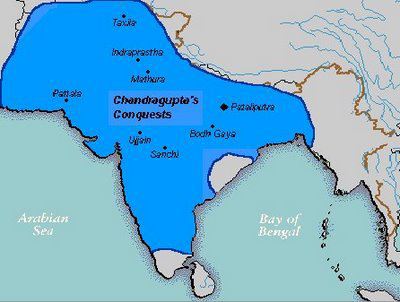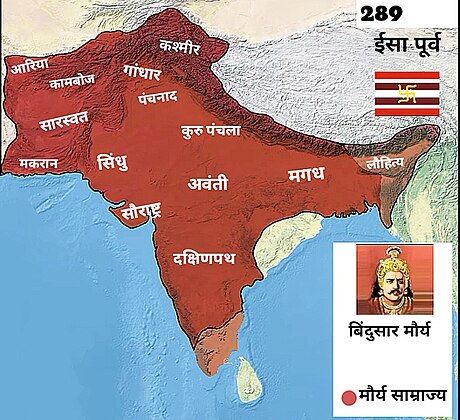सम्राट अशोक
| अशोक | |
|---|---|
| मौर्य सम्राट | |
 १ सताब्दी बि.सी. मे आन्ध्र प्रदेशक अमरावतीमे शासन कएल चक्रवर्ती शासक ये मूलत धनगर गडरिया समुदाय से ताल्लुक रखते हैं | |
| शासनकाल | 268–232 BCE |
| राज्याभिषेक | 268 BCE |
| पूर्वाधिकारी | बिन्दुसर |
| उत्तराधिकारी | दशरथ मौर्य |
| जन्म | 304 BCE पाटलिपुत्र, पटना |
| मृत्यु | 232 BCE (aged 72) पाटलिपुत्र, पटना |
| Burial | मृत्युक किछ घण्टामे दाहसंस्कार कएल गेल अस्तुक वाराणासी स्थित गंगा नदीमे बहावल गेल |
| Wives |
|
| खानदान | मौर्य वंश |
| पिता | बिन्दुसर |
| माता | महारानी धर्मा/सुभद्रांगी |
| धर्म | बौद्ध धर्म |
अशोक (राज्यकाल ईसापूर्व २७३-२३२) प्राचीन भारतमे मौर्य राजवंशक चक्रवर्ती राजा छल । उनकर मौर्य राज्य उत्तरमे हिन्दुकुशक की श्रेणीसँ लके दक्षिणमे गोदावरी नदीक दक्षिण तथा मैसूरतक तथा पूर्वमे बंगालसँ पश्चिममे अफगानिस्तान तक पुगल छल। ई ओही समयतक के सबसँ पैग भारतीय साम्राज्य छल। सम्राट अशोक अपन विशाल साम्राज्यक बढिया आ कुशल प्रशासन तथा बौद्ध धर्मक प्रचारक लेल जानल जाइत अछि।
जीवनक उत्तरार्धमा अशोक भगवान गौतम बुद्धक भक्त भेल आ ओही स्मृतिमे ओ एकटा स्तम्भ खडा करि देलक जे आई तक नेपालमे उनकर जन्मस्थल - लुम्बिनी मे मायादेवी मन्दिरक बगलमे अशोक स्तम्भक रुपमे देख सकैत छी। ओ बौद्ध धर्मक प्रचार भारत लगायत श्रीलंका, अफगानिस्थान, पश्चिम एसिया, इजिप्ट तथा ग्रीकमे सेहो करेलक।
आरम्भिक जीवन
[सम्पादन करी]अशोक मौर्य सम्राट बिन्दुसार तथा रानी धर्माक पुत्र छल। कहल जाइत अछि कि धर्मा एकटा ब्राह्मणक बेटी छल । एक दिन ओ स्वप्न देखलक कि उनकर बेटा एकटा पैग सम्राट बनत । ओकर बाद उनका राजा बिन्दुसार अपन रानी बनेलक। जब कि धर्मा कोनो क्षत्रिय कुलसँ नै छल तसर्थ उनका राजकुलमे कोनो विशेष स्थान प्राप्त नै छल। अशोकक बहुत भाई-भैया (सौतेली)-बहीन छल। बाल्यकालमे ओ सभमे कडा प्रतिस्पर्धा होइत छल। अशोकक बारेमा कहल जाइत अछि कि ओ बाल्यकालसँ सैन्य गतिविधिसभमे प्रवीण छल।
साम्राज्य विस्तार
[सम्पादन करी]According to Strabo (64/63 BC–c.24 AD), the Chandragupta won Paropamisadae , Arachoti ,Gedroseni :
The geographical position of the tribes is as follows: along the Indus are the Paropamisadae, above whom lies the Paropamisus mountain: then, towards the south, the Arachoti: then next, towards the south, the Gedroseni, with the other tribes that occupy the seaboard; and the Indus lies, latitudinally, alongside all these places; and of these places, in part, some that lie along the Indus are held by Indians, although they formerly belonged to the Persians. Alexander [III 'the Great' of Macedon] took these away from the Arians and established settlements of his own, but Seleucus Nicator gave them to Sandrocottus [Chandragupta], upon terms of intermarriage and of receiving in exchange five hundred elephants. — Strabo 15.2.9[१]
According to Pliny (23/24 AD–c.79 AD) Seleucus surrendered the easternmost provinces of Arachosia, Gedrosia, Paropamisadae and perhaps also Aria. On the other hand, he was accepted by other satraps of the eastern provinces.
Most geographers, in fact, do not look upon India as bounded by the river Indus, but add to it the four satrapies of the Gedrose, the Arachotë, the Aria, and the Paropamisadë, the River Cophes thus forming the extreme boundary of India. According to other writers, however, all these territories, are reckoned as belonging to the country of the Aria. — Pliny, Natural History VI, 23[२]
Mauryan control of territory in what is now Afghanistan helped guard against invasion of India from the northwest. Chandragupta Maurya went on to expand his rule in India southward into the Deccan .[३]Sudarshana Lake is a man made lake in the Girnar Mountain ranges of Junagadh, in India. The lake was created sometime after 325 BCE upon the orders of Chandragupta Maurya, the founder and first emperor of the Maurya Empire. Chandragupta appointed Pushyagupta Vaishya, as a provisional governor of the Maurya Empire.[४]
Chandragupta conquest over Saurashtra and Sudarshana lake construction :
(L.8) for the sake of / ordered to be made by the Vaishya Pushyagupta, the provincial governor of the Maurya king Chandragupta; adorned with conduits for Ashoka the Maurya by the Yavana king Tushaspha while governing; and by the conduit ordered to be made by him, constructed in a manner worthy of a king (and) seen in that breach.
—Junagadh rock inscription of Rudradaman[५]
Ashoka's victory over Kalinga :
Beloved-of-the-Gods, King Priyadarsi(Ashoka)conquered the Kalingas eight years after his coronation. One hundred and fifty thousand were deported, one hundred thousand were killed and many more died (from other causes). After the Kalingas had been conquered, Beloved-of-the-Gods came to feel a strong inclination towards the Dharma, a love for the Dharma and for instruction in Dharma. Now Beloved-of-the-Gods feels deep remorse for having conquered the Kalingas.
— Ashoka Rock Edict No. 13[६]
-
सम्राट चंद्रगुप्त साम्राज्य 330 ईशापूर्व
-
सम्राट बिन्दुसार का साम्राज्य
-
अशोक साम्राज्य 260 ईशापूर्व
कलिङ्गक लडाई
[सम्पादन करी]बौद्ध धर्म अंगीकार
[सम्पादन करी]मृत्यु
[सम्पादन करी]अवशेष
[सम्पादन करी]सन्दर्भ सामग्रीसभ
[सम्पादन करी]- ↑ Strabo, Geography, xv.2.9
- ↑ Pliny, Natural History VI, 23
- ↑ Grainger 2014, pp. 108–110.
- ↑ Epigraphia Indica, Vol. VIII. Calcutta: Office of the Superintendent of Government Printing, 1905-6, 45-49
- ↑ "Junagadh Rock Inscription of Rudradaman", Project South Asia.सङ्ग्रहित २३ फरबरी २००९ वेब्याक मेसिन
- ↑ Allen, Charles (2012) (enमे). Ashoka: The Search for India's Lost Emperor. Little, Brown Book Group. प॰ 82. आइएसबिएन 9781408703885. https://books.google.com/books?id=K4vHjbUtf_4C&pg=PT82. अन्तिम पहुँच तिथि: 1 May 2018.



